
FINANCIAL ACCOUNTING
10th Edition
ISBN: 9781259964947
Author: Libby
Publisher: MCG
expand_more
expand_more
format_list_bulleted
Concept explainers
Topic Video
Question
thumb_up100%
All info is included in photo.

Transcribed Image Text:Accountants for Jackson, Inc. have assembled the following data for the year ended December 31, 2024
(Click the icon to view the current accounts)
(Click the icon to view the transaction data)
Prepare Jackson's statement of cash flows using the indirect method. Include an accompanying schedule of non-cash investing and financing activities.
Complete the statement one section at a time, beginning with the cash flows from operating activities (Use a minus sign or parentheses for amounts that result in a decrease in cash If a box is not used in
the statement, leave the box empty, do not select a label or enter a zero)
Jackson, Inc.
Statement of Cash Flows
Year Ended December 31, 2024
Cash Flows from Operating Activities
Net Income
Adjustments to Reconcile Net Income to Net Cash
Provided by (Used for) Operating Activities.
Depreciation Expense
Gain on Sale of Building
Decrease in Accounts Receivable
Increase in Merchandise Inventory
Increase in Accounts Payable
Decrease in Income Tax Payable
Net Cash Provided by (Used for) Operating Activities
Cash Flows from Investing Activities
Net Cash Provided by (Used for) Investing Activities
Cash Flows from Financing Activities
16000
-3500
4900
-6000
2000
-2400
66500
11000
Data table
Current Assets.
Cash
counts Receivable
Merchandise Inventory
Current Liabilities:
Accounts Payable
Income Tax Payable
Print
2024
96,900 $
64,200
85,000
57,700
14,600
Done
2023
22,000
69,100
79,000
55,700
17.000
X

Transcribed Image Text:Accountants for Jackson, Inc. have assembled the following data for the year ended December 31, 2024:
(Click the icon to view the current accounts)
(Click the icon to view the transaction data.)
Prepare Jackson's statement of cash flows using the indirect method. Include an accompanying schedule of non-cash investing and financing activities.
Complete the statement one section at a time, beginning with the cash flows from operating activities. Use a minus sign or parentheses for amounts that result in a decrease in cash. If a box is not used in
the statement, leave the box empty, do not select a label or enter a zero.)
Cash F
Net I
Adjus
Provi
Data table
Transaction Data for 2024:
Issuance of common stock for cash
Depreciation expense
Purchase of equipment with cash
Acquisition of land by issuing long-term notes payable
Book value of building sold
Net Ca
Cash Flows from Investing Activities
Net Cash Provided by (Used for) Investing Activities
Cash Flows from Financing Activities
Print
$ 45,000
16,000
79,000
116,000
61,000
Payment of notes payable
Payment of cash dividends
Issuance of notes payable to borrow cash
Gain on sale of building
Net income
Done
$ 51,100
48,000
66,000
3,500
66,500
X
Expert Solution
This question has been solved!
Explore an expertly crafted, step-by-step solution for a thorough understanding of key concepts.
This is a popular solution
Trending nowThis is a popular solution!
Step by stepSolved in 3 steps

Knowledge Booster
Learn more about
Need a deep-dive on the concept behind this application? Look no further. Learn more about this topic, accounting and related others by exploring similar questions and additional content below.Similar questions
Recommended textbooks for you

 AccountingAccountingISBN:9781337272094Author:WARREN, Carl S., Reeve, James M., Duchac, Jonathan E.Publisher:Cengage Learning,
AccountingAccountingISBN:9781337272094Author:WARREN, Carl S., Reeve, James M., Duchac, Jonathan E.Publisher:Cengage Learning, Accounting Information SystemsAccountingISBN:9781337619202Author:Hall, James A.Publisher:Cengage Learning,
Accounting Information SystemsAccountingISBN:9781337619202Author:Hall, James A.Publisher:Cengage Learning, Horngren's Cost Accounting: A Managerial Emphasis...AccountingISBN:9780134475585Author:Srikant M. Datar, Madhav V. RajanPublisher:PEARSON
Horngren's Cost Accounting: A Managerial Emphasis...AccountingISBN:9780134475585Author:Srikant M. Datar, Madhav V. RajanPublisher:PEARSON Intermediate AccountingAccountingISBN:9781259722660Author:J. David Spiceland, Mark W. Nelson, Wayne M ThomasPublisher:McGraw-Hill Education
Intermediate AccountingAccountingISBN:9781259722660Author:J. David Spiceland, Mark W. Nelson, Wayne M ThomasPublisher:McGraw-Hill Education Financial and Managerial AccountingAccountingISBN:9781259726705Author:John J Wild, Ken W. Shaw, Barbara Chiappetta Fundamental Accounting PrinciplesPublisher:McGraw-Hill Education
Financial and Managerial AccountingAccountingISBN:9781259726705Author:John J Wild, Ken W. Shaw, Barbara Chiappetta Fundamental Accounting PrinciplesPublisher:McGraw-Hill Education


Accounting
Accounting
ISBN:9781337272094
Author:WARREN, Carl S., Reeve, James M., Duchac, Jonathan E.
Publisher:Cengage Learning,

Accounting Information Systems
Accounting
ISBN:9781337619202
Author:Hall, James A.
Publisher:Cengage Learning,

Horngren's Cost Accounting: A Managerial Emphasis...
Accounting
ISBN:9780134475585
Author:Srikant M. Datar, Madhav V. Rajan
Publisher:PEARSON

Intermediate Accounting
Accounting
ISBN:9781259722660
Author:J. David Spiceland, Mark W. Nelson, Wayne M Thomas
Publisher:McGraw-Hill Education

Financial and Managerial Accounting
Accounting
ISBN:9781259726705
Author:John J Wild, Ken W. Shaw, Barbara Chiappetta Fundamental Accounting Principles
Publisher:McGraw-Hill Education